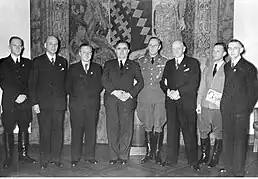Jungdeutsche Partei
Jungdeutsche Partei in Polen (JDP), or the Young German Party in Poland (Polish: Partia Młodoniemiecka w Polsce), was a Nazi German extreme right-wing political party founded in 1931 by members of the ethnic German minority residing in the Second Polish Republic.[1]
| Young German Party in Poland | |
 | |
 Volksdeutsches decorated with the Golden Party Badge by Adolf Hitler in Berlin after Invasion of Poland in 1939. From left: Ludwig Wolff of Deutscher Volksverband, Otto Ulitz, Wagner, Rudolf Wiesner from Bielsko-Biała, Obergruppenführer Werner Lorenz, Erwin Hasbach from Ciechocinek, Gero von Gersdorff from Wielkopolska, and Weiss from Jarocin | |
| Established | 1931 |
|---|---|
| Type | Nazism |
| Headquarters | Bielsko-Biała, Poland |
| Leader | Rudolf Wiesner, Obersturmführer Max Wambeck (1938) |
| Affiliations | Nazi Germany |
| Remarks | Far-right politics |
The party was opposed not only to collaboration with Poland, but also, with other German organizations in Poland.[2] Its leader was Rudolf Wiesner (pictured, fourth from the left), a committed Nazi.[3] He was replaced by Max Wambeck from NSDAP on 22 November 1938.[4] After the invasion of Poland Wambeck (fluent in Polish, known as Maksymilian Wambeck locally)[5] served as SS-Obersturmführer in Chodzież in the Gnesen Gau (Polish Gniezno County) interrogating and torturing Armia Krajowa resistance members.[4]
Activities
Sponsored financially by the Ministry of Foreign Affairs of Nazi Germany, the Jungdeutsche Partei members trained in propaganda, sabotage and espionage activities against the Polish state,[6] smuggled military weapons,[7] and waged a campaign of intimidating other members of the community to leave for Nazi Germany, with tangible incentives.[6] A considerable number of young Polish Germans joined the rank-and-file of the Party during the mid-1930s as a result of Nazi indoctrination and aggressive recruitment.[8] The party had its own flag with JdP symbol in it, celebrated anniversaries (Heldengedenktag), a hymn sung at gatherings (Jungdeutsche marschiert) with a Nazi salute, and its own red armbands similar to NSDAP.[9]
The Jungdeutsche Partei was formed originally in 1921 in Bielsko-Biała as the Deutscher Nationalsozialistischer Verein in Polen. Renamed in 1931 the party gradually expanded its activities to cover most of Upper Silesia with 1,200 members,[10] and other regions such as Greater Poland (since 1934) as well as Pomerania and Volhynia in the following years.[11][12] The public rallies held by the party were aggressively anti-Polish, rabidly racist, and anti-Jewish; while proclaiming to the world: "We want to be Germans, and nothing but Germans."[13] JDP was dissolved by Adolf Hitler after the invasion of Poland with transfer of its membership to Germany.[14]
See also
- Deutscher Volksverband, the German People's Union in interwar Poland
- Deutsche Vereinigung, the German minority organization from northern Poland
- Sonderdienst, Nazi German paramilitary formations created after the invasion
Notes and references
- Richard Blanke (1993). The Impact of National Socialism. pp. 170, 247. ISBN 0813118034.
{{cite book}}:|work=ignored (help) - Herbert A. Strauss (1993). Current Research on Anti-Semitism: Hostages of Modernization, Volumes 2–3. Walter de Gruyter. p. 986. ISBN 3110137151.
- Neil Gregor; Nils H. Roemer; Mark Roseman (2006). Jungdeutsche Partei in "Volksgemeinschaften unter sich" by Winson Chu. pp. 118–119. ISBN 0253347432.
{{cite book}}:|work=ignored (help) - Waldemar L. Janiszewski (10 September 2011). "Mroczne tajemnice senatora (Dark secrets of a senator)". Regionalny Portal Informacyjny Dziennik Nowy.pl. Archived from the original on 12 September 2014. Retrieved 12 September 2014.
- Karol Grünberg (1963), page 223.
- H. Kennard to Viscount Halifax (August 24, 1939). "The British War Bluebook". 2008 Lillian Goldman Law Library. Retrieved 11 September 2014.
- Wacław Uruszczak (2012). Krakowskie Studia z Historii Państwa i Prawa Vol. 5. Wydawnictwo UJ. p. 339. ISBN 978-8323388685.
- Karol Grünberg (1963). Nazi Front Schlesien: niemieckie organizacje polityczne w województwie Śląskim w latach 1933–1939. Wydawnictwo Śląsk, Katowice.
Historic photos.
{{cite book}}: External link in|quote= - Prof. Ryszard Kaczmarek; Instytut Historii Uniwersytetu Śląskiego. "Niespełnione nadzieje (Hopes unfulfilled)". Tygodnik Onet.pl. Retrieved 12 September 2014.
Tygodnik Powszechny: Krwią i blizną (21/11)
- Karol Grünberg (1963), page 170.
- Bundesarchiv Berlin Lichterfelde (2014). "Jungdeutsche Partei für Polen". Reconstitution of the Memory of Poland. Naczelna Dyrekcja Archiwów Państwowych. Retrieved 12 September 2014.
- Karol Grünberg (1963), page 65.
- Claus-Christian W. Szejnmann; Maiken Umbach (18 January 2016). Heimat, Region, and Empire: Spatial Identities under National Socialism. Palgrave Macmillan. pp. 77–79. ISBN 978-0230391123.
- Jarosław Gdański (2011). "Dobrzy Niemcy w polskich mundurach (Good Germans in Polish uniforms)". Inne Oblicza Historii ioh.pl. Retrieved 12 September 2014.